Tag: sourceedit |
(Adding categories) |
||
| (24 intermediate revisions by 2 users not shown) | |||
| Line 1: | Line 1: | ||
| − | A '''House, ''' |
+ | A '''House, ''' variously known as a '''Shack, Cottage, Hut, Cabin '''and '''Shanty, ''' was a place usually built by [[men]], [[elves]], [[dwarves]] and [[orcs]], to use as a dwelling place for them. Some houses were hideouts to [[bandits]] and marauders, while others were not built for dwelling, but for other uses such as farming. |
| + | |||
| + | The Term could also be used to denote a specific Household, Clan or Noble Family, see: |
||
| + | *[[Houses]] or [[Great Houses and Families]] |
||
| + | |||
| + | ==Adanic Architecture== |
||
| + | |||
| + | *[[Cerin Haleth]] |
||
| + | *[[Haldir's Hall]] |
||
| + | *[[Húrin's Hall]] |
||
==Daen Architecture== |
==Daen Architecture== |
||
| Line 5: | Line 14: | ||
[[File:LondGalen.jpg|thumb|Fishermen's Houses in Lond Galen]] |
[[File:LondGalen.jpg|thumb|Fishermen's Houses in Lond Galen]] |
||
[[File:Mirkalvill.jpg|thumb|309px|Mountaineer's Village in the Ered Nimrais]] |
[[File:Mirkalvill.jpg|thumb|309px|Mountaineer's Village in the Ered Nimrais]] |
||
| + | |||
| + | The [[Daen]]-peoples originally built simple buildings, small Stone-Houses thatched with straws or reeds for the most part, later they developed, inspired by their contacts to the [[Númenóreans]] more complex buildings without ever leaving behind their original traditions. The [[Dunmen]] of southern [[Eriador]] and the [[Men of the white Mountains]] were the most conservative factions, the Dunmen kept building their traditional oval- or roundhouses and low circular towers, while both tribes also built more conventional wooden- and framework buildings with square or rectangular outlines. |
||
*[[Bannog Cadlus]] |
*[[Bannog Cadlus]] |
||
*[[Baranor's Farm]] |
*[[Baranor's Farm]] |
||
| ⚫ | |||
*[[The Cabden]] |
*[[The Cabden]] |
||
*[[Cartrev Emlun]] |
*[[Cartrev Emlun]] |
||
*[[Cartrev Hamon]] |
*[[Cartrev Hamon]] |
||
| ⚫ | |||
*[[Glorfindel's Hut]] |
*[[Glorfindel's Hut]] |
||
*[[Healer´s Hall]] of [[Dunfearan]] |
*[[Healer´s Hall]] of [[Dunfearan]] |
||
*[[Hoeg's House]] |
*[[Hoeg's House]] |
||
*[[Hermit's Cottage]] at [[Eryn Vorn]] |
*[[Hermit's Cottage]] at [[Eryn Vorn]] |
||
| − | *[[ |
+ | *[[Hillman]] [[Taigh]] |
*[[Malm Bairg's Tower]] |
*[[Malm Bairg's Tower]] |
||
*[[Mar Hogo Clan-Hold]] |
*[[Mar Hogo Clan-Hold]] |
||
| − | *[[ |
+ | *[[Ruem's Hut]] |
*[[Temple of Justice]] |
*[[Temple of Justice]] |
||
*[[Temple of Suceva]] |
*[[Temple of Suceva]] |
||
| Line 26: | Line 39: | ||
[[File:ShrelKain2.jpg|thumb|Houses in Szrel-Kain]] |
[[File:ShrelKain2.jpg|thumb|Houses in Szrel-Kain]] |
||
[[File:ShrelKain.jpg|thumb|Dorwinian Hall]] |
[[File:ShrelKain.jpg|thumb|Dorwinian Hall]] |
||
| + | |||
| + | Dorwinian Architecture shared many elements with both, early [[Easterling]] and [[Daen]] works and typical [[Northman]] Longhouses, but dorwinian Buildings often were more flat and squat, having two-or three levels and often porch-roofs based on wooden pillars.An obvious influence from the East were their skillful gables and ridged roofs which were often adorned with complex carvings. |
||
*[[Krulla's Farm]] |
*[[Krulla's Farm]] |
||
| Line 33: | Line 48: | ||
==Drûghu Architecture== |
==Drûghu Architecture== |
||
| + | *Drúadan [[Fogu]] |
||
*[[Hidden Shrine]] |
*[[Hidden Shrine]] |
||
| + | *[[Wose passage hold]] |
||
==Dwarven Architecture== |
==Dwarven Architecture== |
||
| Line 63: | Line 80: | ||
[[File:Talma.jpg|thumb|396px|Silvan Talan or Tree-Fort]] |
[[File:Talma.jpg|thumb|396px|Silvan Talan or Tree-Fort]] |
||
| + | The Wild Elves, the [[Nandor]] and [[Avari]] built simple but beautiful wooden-houses, often entangled in living plants or trees known as [[Galadhrynd]] or [[Elvish Glades]].The most notable of these structures were the [[Telain]], buildings on wooden platforms high in great trees although only the [[Mellyrn]] of [[Lórien]] grew tall enough for Telain of greater dimensions.The greater Telain structures could be interwoven [[Talma]]r or Tree-Forts. |
||
| − | Noldor: |
||
| + | |||
| + | The earliest,or most archaic, elven housetypes were slender cottages (indeed the early [[Edain]] had based their own early wooden housetypes on inspiration drawn from elven cottages) called "Mar" (S."Bar"), the term would also be applied to larger complexes of attached buildings (Elrond's house in [[Rivendell]] for example), or "Os(t)" which would later become a common term for military structures such as keeps and Castles, which at their earliest stage had been more or less reinforced and fortified settlements. |
||
| + | The more sedentary [[Sindar]], and some [[Nandor]] under their influence, developed these rather primitive housetypes into beautiful, long and usually one-storied huts (compare the raft-elven huts of [[Celebannon]] they called "adab". |
||
| + | |||
| + | The [[High-Elves]] and [[Sindar]] built long houses, preferring light or white stone or stucco, with high rooms and high roofs based on pointed archs.However the by far renowned architects among the [[Eldar]] were the Noldor. |
||
The [[Noldor]] were master [[architect]]s |
The [[Noldor]] were master [[architect]]s |
||
| Line 77: | Line 99: | ||
The cities had an extensive plumbing and sewage systems; virtually |
The cities had an extensive plumbing and sewage systems; virtually |
||
every building had running water and complete sanitary facilities. |
every building had running water and complete sanitary facilities. |
||
| + | Many of their fortresses were designed as hill-forts. |
||
| + | |||
| + | A special housetype of the High-Elves was the Korin, any type of greater walled house, village or town would be considered an "opelë" (Q."Walled Dwelling") by the Tareldar. |
||
Individual Houses: |
Individual Houses: |
||
| Line 109: | Line 134: | ||
[[File:Enthall.jpg|thumb|Typical Enthouse]] |
[[File:Enthall.jpg|thumb|Typical Enthouse]] |
||
| + | |||
| + | Ents did not build houses, instead they used natural features, high trees, caves, hills, meadows and Wells and engaged trees and other plants to grow into protective structures they called ''Enthouses''. |
||
*[[Derndingle]] |
*[[Derndingle]] |
||
| Line 124: | Line 151: | ||
[[File:Hut.jpg|thumb|304px|Arthadan Farmer's Hut]] |
[[File:Hut.jpg|thumb|304px|Arthadan Farmer's Hut]] |
||
[[File:Manor.png|thumb|400px|Rhudaurian Manor]] |
[[File:Manor.png|thumb|400px|Rhudaurian Manor]] |
||
| + | |||
| + | Eriadorian Architecture was based on many influences, including Daen, Númenórean and Northron.The most typical Eriadorian building was the low, rectangular , reed- or slate-thatched cottage of half-timber framework and brown, reddish or white stonework and finery. |
||
*[[Axebridge]] Farm in [[the Shire]] |
*[[Axebridge]] Farm in [[the Shire]] |
||
| Line 168: | Line 197: | ||
==Giant's Architecture== |
==Giant's Architecture== |
||
| + | *[[giant-home]] of [[Dunland]] |
||
*[[Svalfang's Hut]] |
*[[Svalfang's Hut]] |
||
| Line 188: | Line 218: | ||
*[[Red Sunset tavern]] |
*[[Red Sunset tavern]] |
||
*[[Shrine of Sunrises]] |
*[[Shrine of Sunrises]] |
||
| ⚫ | |||
*[[Temple of the Blood-drinkers]] |
*[[Temple of the Blood-drinkers]] |
||
| − | *[[ |
+ | *[[Temples of the One-Person]] |
*[[Tower of Birds]] |
*[[Tower of Birds]] |
||
| Line 220: | Line 249: | ||
*[[Rendwalk Inn]] |
*[[Rendwalk Inn]] |
||
*[[Sandson Farm]] |
*[[Sandson Farm]] |
||
| ⚫ | |||
*[[Wildland Inn]] |
*[[Wildland Inn]] |
||
==Lossoth Architecture== |
==Lossoth Architecture== |
||
| + | |||
| + | The [[Lossoth]] were known to built houses in the snow, not quite out of snow or ice-blocks (although this was possible in some of the coldest areas of the [[Forodwaith]]) but settled huts out of frameworks ,bone, leather and pelts. |
||
*[[Ashkia Temple]] |
*[[Ashkia Temple]] |
||
| Line 229: | Line 261: | ||
==Northman Architecture== |
==Northman Architecture== |
||
| + | |||
| + | The Northmen had, of all mannish cultures of the Westlands, perpetuated the ancient tradition of the [[Adan]]ic wooden-halls for the longest time.Their most traditional housetype were large and relatively low [[Longhouse]]s, the [[Gramuz]] built longhouses consisting of two interwoven hallways called [[Bidahus]] which they concentrated into larger settlements known as[[Alanbaurg]]s.The [[Medvo Hus]] or [[Medwe Hus]]as of the [[Éothéod]] and [[Beornings]] where much higher and usually consited of one great hall with several smaller and lower rooms attached to it.In later times the [[Rohirrim]], influenced by gondorian architecture, advanced into the building of far greater structures, often with several levels.The [[Lakemen]] built the most complex kind of northron-house, their long [[Lakehouse]]s could incorporate homes of several families and could even, influenced by elvish telain, be interwoven into complex assemblies of many buildings interconnected by complex bridges and stairways consisting of multiple-floored structures and with high pyramidal broach roofs and slender towers.The [[Woodmen]] still built wooden halls of the most simple type but sometimes, inspired by the [[Silvan-Elves]], built their small settlements upon [[Flet]]s, high up in the mightiest trees of [[Mirkwood]], however these Woodman Flet-houses still were nothing but northron longhouses built on high wooden platforms (See:[[Woodmen-Town]]). |
||
[[File:Northmenhome.jpg|thumb|290px|Typical Northman-home]] |
[[File:Northmenhome.jpg|thumb|290px|Typical Northman-home]] |
||
| Line 259: | Line 293: | ||
*[[Hidden Shrine]] |
*[[Hidden Shrine]] |
||
*[[Inn of the Sixth Sense]] |
*[[Inn of the Sixth Sense]] |
||
| + | *[[Juggler's Hall]] |
||
*[[Magla's Home]] |
*[[Magla's Home]] |
||
*[[Meduseld]] |
*[[Meduseld]] |
||
| Line 338: | Line 373: | ||
[[File:Village.jpg|thumb|330px|Orcish Earthwork-Huts]] |
[[File:Village.jpg|thumb|330px|Orcish Earthwork-Huts]] |
||
| + | *[[Kosh-Largat]] |
||
| + | *[[Kosh-Madh]] |
||
| + | *[[Kosh-Vor]] |
||
| ⚫ | |||
| + | *[[Shart ap-Krûal]] |
||
*[[Skull Wood Shrine]] |
*[[Skull Wood Shrine]] |
||
| Line 349: | Line 389: | ||
==Further Examples== |
==Further Examples== |
||
| + | |||
| ⚫ | |||
| ⚫ | |||
*A [[Hunter]]'s Hut |
*A [[Hunter]]'s Hut |
||
*A [[Mage]]'s Cabin |
*A [[Mage]]'s Cabin |
||
| Line 357: | Line 396: | ||
*A Storage House |
*A Storage House |
||
*An Abandoned Cottage |
*An Abandoned Cottage |
||
| ⚫ | |||
*A Manor |
*A Manor |
||
*A [[Fisher]]'s Cottage |
*A [[Fisher]]'s Cottage |
||
| − | *[[Hillman]] [[Taigh]] |
||
[[Category:Lore]] |
[[Category:Lore]] |
||
[[Category:Culture]] |
[[Category:Culture]] |
||
| + | [[Category:Needs to be done]] |
||
Revision as of 23:25, 3 May 2020
A House, variously known as a Shack, Cottage, Hut, Cabin and Shanty, was a place usually built by men, elves, dwarves and orcs, to use as a dwelling place for them. Some houses were hideouts to bandits and marauders, while others were not built for dwelling, but for other uses such as farming.
The Term could also be used to denote a specific Household, Clan or Noble Family, see:
Adanic Architecture
- Cerin Haleth
- Haldir's Hall
- Húrin's Hall
Daen Architecture

Fishermen's Houses in Lond Galen

Mountaineer's Village in the Ered Nimrais
The Daen-peoples originally built simple buildings, small Stone-Houses thatched with straws or reeds for the most part, later they developed, inspired by their contacts to the Númenóreans more complex buildings without ever leaving behind their original traditions. The Dunmen of southern Eriador and the Men of the white Mountains were the most conservative factions, the Dunmen kept building their traditional oval- or roundhouses and low circular towers, while both tribes also built more conventional wooden- and framework buildings with square or rectangular outlines.
- Bannog Cadlus
- Baranor's Farm
- A Cabden
- The Cabden
- Cartrev Emlun
- Cartrev Hamon
- dunnish hut
- Glorfindel's Hut
- Healer´s Hall of Dunfearan
- Hoeg's House
- Hermit's Cottage at Eryn Vorn
- Hillman Taigh
- Malm Bairg's Tower
- Mar Hogo Clan-Hold
- Ruem's Hut
- Temple of Justice
- Temple of Suceva
Dorwinian Architecture
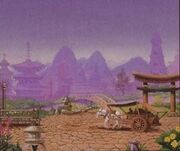
Houses in Szrel-Kain
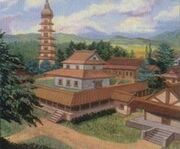
Dorwinian Hall
Dorwinian Architecture shared many elements with both, early Easterling and Daen works and typical Northman Longhouses, but dorwinian Buildings often were more flat and squat, having two-or three levels and often porch-roofs based on wooden pillars.An obvious influence from the East were their skillful gables and ridged roofs which were often adorned with complex carvings.
- Krulla's Farm
- Temple of Kuka Posladni
- Valgavia Rogatha's Hut
Drûghu Architecture
- Drúadan Fogu
- Hidden Shrine
- Wose passage hold
Dwarven Architecture
- Bar-en-Ibun
- Coldforge at Moria
- Gnome's earth chalet
- Khalarazûm
- Thrasi's Lodge
Easterling Architecture

Easterling Hut

Easterling Hut interior
- Arch of the last Sovereign
- Broddas's Hall
- Duranki High Temple
- Eight Tiered Hall
- House of T'revor Arain
- Purple House
- Temple of Araw
- Temple of Lôkuthor
- shrine of sinuphel
Elvish Architecture
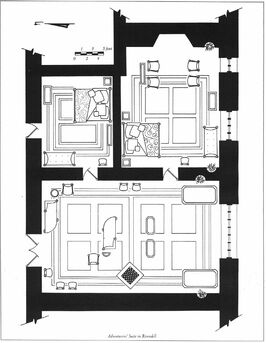
Elvish Dwelling in Rivendell
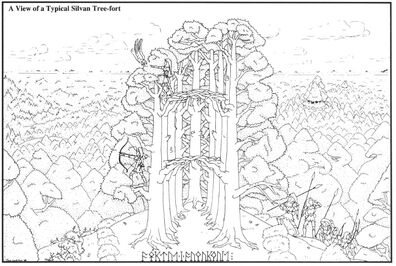
Silvan Talan or Tree-Fort
The Wild Elves, the Nandor and Avari built simple but beautiful wooden-houses, often entangled in living plants or trees known as Galadhrynd or Elvish Glades.The most notable of these structures were the Telain, buildings on wooden platforms high in great trees although only the Mellyrn of Lórien grew tall enough for Telain of greater dimensions.The greater Telain structures could be interwoven Talmar or Tree-Forts.
The earliest,or most archaic, elven housetypes were slender cottages (indeed the early Edain had based their own early wooden housetypes on inspiration drawn from elven cottages) called "Mar" (S."Bar"), the term would also be applied to larger complexes of attached buildings (Elrond's house in Rivendell for example), or "Os(t)" which would later become a common term for military structures such as keeps and Castles, which at their earliest stage had been more or less reinforced and fortified settlements. The more sedentary Sindar, and some Nandor under their influence, developed these rather primitive housetypes into beautiful, long and usually one-storied huts (compare the raft-elven huts of Celebannon they called "adab".
The High-Elves and Sindar built long houses, preferring light or white stone or stucco, with high rooms and high roofs based on pointed archs.However the by far renowned architects among the Eldar were the Noldor.
The Noldor were master architects and engineers as well as artists, and because of their superior skill were able to overcome many of the mundane structural obstacles of building. As a result, designs were daring: balconies, cantilevers and wide spans were frequently used. Supports were slender and graceful. leaving space available for many large windows — and the glassworkers of Ost-in-Edhil had no equal elsewhere. Multipaned, stained glazes were used everywhere in elegant designs and patterns. Beautiful crystal lamps were everywhere at night, lighting the streets, the gardens, and the buildings with at warm glow. The cities had an extensive plumbing and sewage systems; virtually every building had running water and complete sanitary facilities. Many of their fortresses were designed as hill-forts.
A special housetype of the High-Elves was the Korin, any type of greater walled house, village or town would be considered an "opelë" (Q."Walled Dwelling") by the Tareldar.
Individual Houses:
- Car Sidh
- Ceber Fanuin
- Cerin Amroth
- Cottage of Lost Play
- Cottage of the Children
- Estate of Carnil the Vintner
- Gildor's Halls
- Halls of Celeborn and Galadriel
- house of Deneloth
- House of Dior
- House of Elms
- House of the Hundred Chimneys
- House of the Mole
- House of the Wind
- Korin of Meril-i-Turinqi
- Last Homely House
- Laurre's Manor
- Long-spring House
- Mirdaithrond in Eregion
- Nahír's Arboretum
- Rodrim's hall
- Tawarobel
- Telpemár
- Tingled Vine Tavern
- Villa of Randae Terisonen
Entish Architechture

Typical Enthouse
Ents did not build houses, instead they used natural features, high trees, caves, hills, meadows and Wells and engaged trees and other plants to grow into protective structures they called Enthouses.
- Derndingle
- Leaflock's Mead
- Quickbeam's House
- Springview Estate
- Treebeard´s Hill
- Wellinghall
Eriadorian Architecture

Eriadorian Lockhouse at Bree

Hermit's Cottage in Eryn Vorn

Commoners Houses in Cardolan

Arthadan Farmer's Hut

Rhudaurian Manor
Eriadorian Architecture was based on many influences, including Daen, Númenórean and Northron.The most typical Eriadorian building was the low, rectangular , reed- or slate-thatched cottage of half-timber framework and brown, reddish or white stonework and finery.
- Axebridge Farm in the Shire
- Bar-i-Dagorath
- Bombadil's House
- Brigid's Cottage
- Chetwood-Inn
- Commonwell
- Deephallow House at Flynettle
- Dongorath's Hold
- Edileaf House
- Fernwood Farm
- Ferny House
- Forsaken Inn
- Fottred´s Farm
- Fulcwian's House
- Garbert´s cottage
- Gatson's Farm
- Gerse's Shrine at Gersebroc
- Hannei's tree-house
- Hearthwood Farm
- Heathertoe Farm
- Hodge's Farm
- Hunting Lodge
- King's Rest Inn
- Last Inn
- Mainstay Inn
- Nightshade Sanctuary
- Rond Morvin
- Thistledew Farm
- The Watermill
- Peake's Farm
- Prancing Pony
- Reeve' s house at Bywater
- Rond Morvin
- Saeradan's Cabin
- Tateshalla
- Trollhead
- Two Waters Inn
- Water Serpent Inn
- Witbert's House
- Woodhall
Giant's Architecture
- giant-home of Dunland
- Svalfang's Hut
Haradrim Architecture

Typical Haradron House

Large Haradron Mansion

Inner of a Tribal Conjurer's Cottage

Port on the Harad Coast

Wealthy Homes at Tûl Isra
- Drunken Southron Inn
- Green Robe College
- Hospice of Lost Faith
- House of the Black Hand
- Iceseller's Estate
- Joghul's Shrine
- Ninefold School
- Palace of Water
- Red Sunset tavern
- Shrine of Sunrises
- Temple of the Blood-drinkers
- Temples of the One-Person
- Tower of Birds
Hobbitish Architecture
- Bamfurlong
- Blushing Ivy Tavern
- Brandy Hall
- Brownlock Farm
- Bucklebury Tavern
- Clarly Hall
- Cotton Farm
- Crickhollow
- Floating Log Inn
- Glen
- Golden Perch Inn
- Gorbuck Hall
- Green Dragon Inn
- Greenshin's Farm
- hal´s farm
- Hawkswell Farm
- Hobwood Inn
- Ivy Bush inn
- Mathom House
- milo´s farm
- Nackers Tavern
- Oatbarton Grange
- Old Odo's Leaf Farm
- Rendwalk Inn
- Sandson Farm
- Southtook Manor
- Wildland Inn
Lossoth Architecture
The Lossoth were known to built houses in the snow, not quite out of snow or ice-blocks (although this was possible in some of the coldest areas of the Forodwaith) but settled huts out of frameworks ,bone, leather and pelts.
- Ashkia Temple
- Jänisleiri
- Voitelta
Northman Architecture
The Northmen had, of all mannish cultures of the Westlands, perpetuated the ancient tradition of the Adanic wooden-halls for the longest time.Their most traditional housetype were large and relatively low Longhouses, the Gramuz built longhouses consisting of two interwoven hallways called Bidahus which they concentrated into larger settlements known asAlanbaurgs.The Medvo Hus or Medwe Husas of the Éothéod and Beornings where much higher and usually consited of one great hall with several smaller and lower rooms attached to it.In later times the Rohirrim, influenced by gondorian architecture, advanced into the building of far greater structures, often with several levels.The Lakemen built the most complex kind of northron-house, their long Lakehouses could incorporate homes of several families and could even, influenced by elvish telain, be interwoven into complex assemblies of many buildings interconnected by complex bridges and stairways consisting of multiple-floored structures and with high pyramidal broach roofs and slender towers.The Woodmen still built wooden halls of the most simple type but sometimes, inspired by the Silvan-Elves, built their small settlements upon Flets, high up in the mightiest trees of Mirkwood, however these Woodman Flet-houses still were nothing but northron longhouses built on high wooden platforms (See:Woodmen-Town).

Typical Northman-home

Rohirric Longhouse
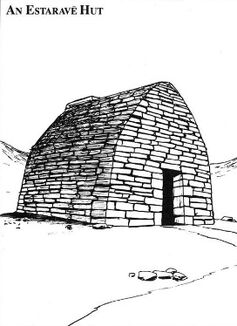
Eastarave-Brickhouse in East-Angmar
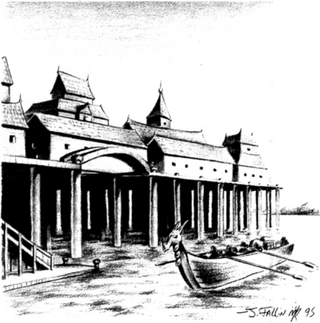
Lake-man Longhouses at Esgaroth

Lakeman Guild-Halls at Esgaroth
[[

Rhovanian Marketplace

Interior of a Northman Hall
- Abandoned Farm of Eorlsmead
- Alduringard
- Beawyn's Cottage
- Beorn´s House
- Beornan's Home
- Biarnarkur
- Bosa's Farm
- Brugath Traim
- Camlan's Refuge
- Cuthbald's Farm
- Dyn Odoric
- Edsig's Farm
- Felagsgard
- Folcbur's Homestead
- Gárferth's Farm
- Gárnoth's Farm
- Gársig's Farm
- Grimbeorn's House
- Haunted Inn
- Hidden Shrine
- Inn of the Sixth Sense
- Juggler's Hall
- Magla's Home
- Meduseld
- Old Sawmill
- Pendlac's Farm
- Prospector's Shack
- Randgar's Farm
- Rhosgobel
- Rof's Wood-Cave
- Sarn Lothduin
- Setborg
- Snotorn manor
- Strayhold Inn
- Theatre of Minas Ithil
- Thrainhuil
- Thrymm's Farm
- Ure's cottage
- Vacant Mill
- Vodgarazun
- Waetan's Lodge
- Wagunhalla
- Wessun's Farm
- Wittabord
Númenórean Architecture

Arnorian Guildhouse

Gondorian Farmstead

Noble Houses at Minas Ithil
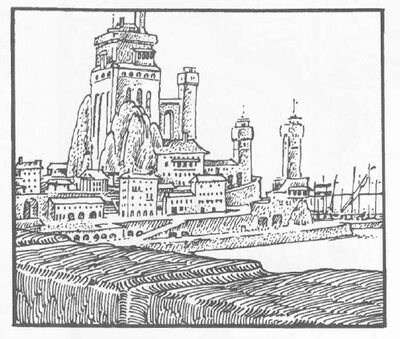
Noble Estates in Dol Amroth

Royal Court at Minas Arnor

Smith's Guild at Minas Tirith

Númenórean Shrine
- Aerthir Lighthouse
- Aldarion's House
- Araphor's Manor
- Ascarnil's Place
- Bar Eketya
- Bar-en-Uinendil
- Caranthor's Shrine
- Cerisan Manor at Osgiliath
- Dunsûl's Manor
- Forlong's Hall
- Gethron's Manor
- Golodhros Manor
- Hall of Malkôra
- Hall of the Uinendili
- Hallacar's Manor
- Hostel of the Sisters of Nienna
- House of Eldacar at Minas Tirith
- House of Gold and Silver in Minas irith
- House Harnastin at Minas Tirith
- House Rian
- Houses of Healing
- Inn of Greys
- Karas Nul at Ûrlond
- King' s House in Osgiliath
- King's House at Tharbad
- Limlight Gatehouse
- Mar Maliarnin Estate
- Palace of Ûrezayan
- Parth Mallin
- Rond Hyarr
- Rynd Permaigwain
- Suul-dhurn
- Taramon's Villa
- Tarmabar
- Tatharond
- Terimbrel's House at Minas Tirith
- Terellisce Formenyaron
- Tol Lammenfirith
- Vamag
- White House of Erendis
- Woodwright's House at Minas Tirith
Orcish Architechture

Orcish Earthwork-Huts
- Kosh-Largat
- Kosh-Madh
- Kosh-Vor
- An Orc Hut
- Shart ap-Krûal
- Skull Wood Shrine
Valarin Architecture
- dark hall
- First Temple
- Fúi
- Grim Hall
- Orome's Halls
